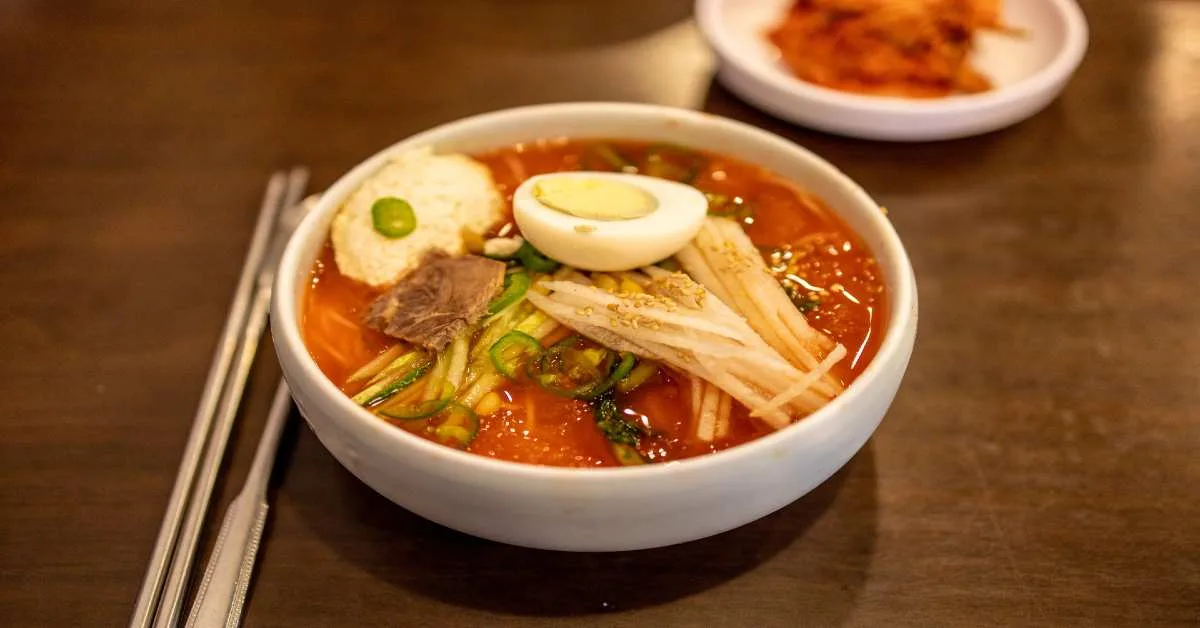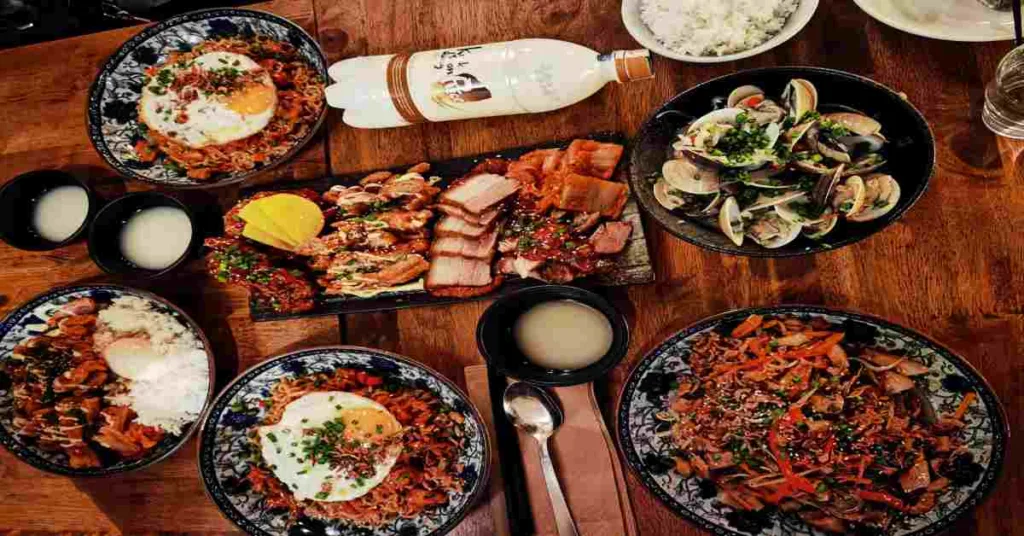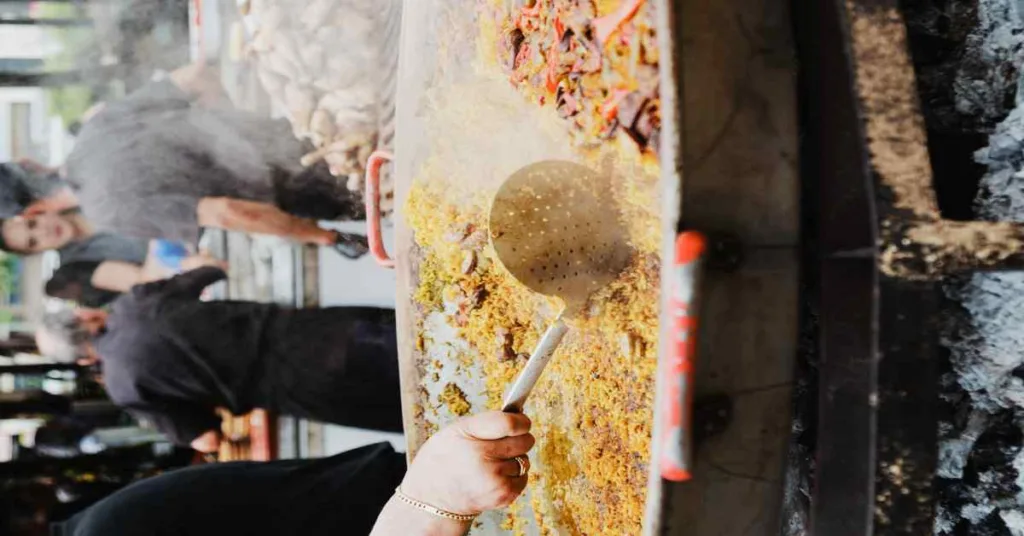Famous Korean food kimchi Worldviajar ingredients
Kimchi is the first thing that comes to mind when we hear the word “Korean food.” The most popular fermented food in Korean cuisine is this. This Shilla Dynasty-era traditional Korean food has a more than 2,000-year history. The ingredients for Kimchi in Korea are Korean cabbage, radish, carrot, onion, ginger, scallion, chilli powder, crushed garlic, and salted fish. Kimchi is then left to ferment.
This regional food is eaten alone, with white rice, as an ingredient in porridges, soups, and rice cakes, and there are more than 200 different variations of it available in Seoul. Furthermore, kimchi is the base for many dishes that are made from it, such as kimchi fried rice, kimchi pancakes, and Kimchi stew (kimchi jjigae). Korean cuisine would not be considered complete without this delectable side dish.
This most popular variety is remarkably versatile as well! You can either eat it raw or use it in cooking. It’s a delectable food with lots of health benefits, too.
Content:
- What is Kimchi?
- What does Kimchi taste like?
- Benefits of homemade Kimchi
- Kimchi recipe
- How to store Kimchi?
- Recipes using Kimchi
What is Kimchi?
Famous Korean food kimchi, which is made from fermented cabbage, radish, or cucumber, is a popular side dish in Korea. There may also be spinach, scallions, beets, cucumber, eggplant, radish, celery, carrots, and bamboo shoots. It is consumed with nearly all Korean meals by the majority of Koreans at least once every day. The most popular kimchi variants include oi kimchi, Kkakdugi, and Baechu (made with napa cabbage & cucumber).
One of the oldest and maybe the most significant dishes in Korean cuisine is kimchi, a sour and spicy dish created from fermented vegetables. Koreans make their kimchi in a variety of methods depending on the season and the purpose. Cabbage kimchi is probably the most well-known and widely consumed kimchi in Korea. Every region of Korea has a unique kimchi recipe that calls for a unique blend of ingredients and cooking methods.
Famous Korean food kimchi can be eaten fresh, or unfermented, right away after preparation, despite the fact that it is usually fermented for a few days to a few weeks before serving.
What does Famous Korean food kimchi taste like?
Each variety of kimchi has its own flavour, and the flavour is very rich. It is first mildly salty because it has been pickled in a salty brine lasting ranging from 30 minutes to overnight. It is additionally seasoned with Korean fish sauce to boost flavour development and hasten the fermentation process. Ripe kimchi has a pungent aroma and is acidic. At this point, kimchi is perfect for cooking.
- Crisp and crunchy texture.
- Vinegar shouldn’t be used in any kimchi recipes.
- Kimchi shouldn’t be very salty, even though a significant amount of salt is used as a brine.
- A good kimchi should leave your mouth feeling crisp and clean.
- It should be scarlet red in colour rather than brown, which is a sign of good chilli flakes.
Although many people enjoy the Famous Korean food kimchi, many people loathe it because of the dish’s strong garlic flavour and scent. The flavour and smell will also get stronger over time.
Benefits of homemade Famous Korean food kimchi
Kimchi is very healthy to consume. The advantage of making your own kimchi is that you may choose the components to alter the flavour. When you make it at home, you can add ingredients that meet your dietary requirements, such as vegan kimchi.
- Healthy bacteria and probiotics found in kimchi are helpful in lowering cholesterol and enhancing gut health.
- It can help reduce the risk of developing serious medical conditions like diabetes and stroke because it is rich in antioxidants and anti-ageing effects.
- Kimchi has a long list of vitamins, minerals, and fibre. Many green vegetables are great sources of riboflavin and vitamin K. A great source of these vitamins and minerals is kimchi, which is typically made from green vegetables including spinach, cabbage, and celery.
- Vitamin K is essential for various bodily functions, including bone metabolism and blood clotting, while riboflavin helps control energy production, cellular growth, and metabolism.
Additionally, research suggests consuming kimchi may lower the risk of heart disease.
Ingredients for Famous Korean food kimchi:
- Napa cabbage
- Korean radish
- Carrot
- Water
- Korean sea salt
- Cooking salt
- Sweet rice flour
- Gochugaru (Korean chilly flakes)
- Korean fish sauce
- Garlic
- Ginger
- Sugar
Famous Korean food kimchi
This is the recipe for the traditional Famous Korean food kimchi uses basic ingredients and is suitable for beginners. You can produce healthy Kimchi at home quickly and effortlessly if you follow the step-by-step directions and crucial kimchi-making guidelines.
Step 1:
Firstly, take the napa cabbage and then cut it into quarters and rinse it in running water. Make sure the stem is intact. Dissolve the coarse salt in the water in a large bowl. Dip the napa cabbage in the saltwater one at a time and transfer it onto a tray for further salting.
Step 2:
Gently unfold each leaf, then add salt to the thick, white portion. Do this once again with the remaining cabbage. Save the saltwater you used to soak the cabbage so you can use it later.
Step 3:
The wedge side of the salted cabbage should be facing up in a big bucket or food-grade plastic bag. Pour the reserved saltwater from step 2 over the cabbage. Snap the plastic bag shut. Use a heavy object to press down on the cabbage. To pickle the cabbage, leave it out for six hours. Every two hours, turn the cabbage upside-down.
Step 4:
After the soaking process is complete, rinse the cabbages under running water to remove the salt, paying specific attention to the thick, white section of the cabbage. They should spend an hour draining in a colander.
Make the sticky rice paste while you wait. In a saucepan, combine the water and glutinous rice flour, and cook the mixture for 5-8 minutes, or until it thickens. Transfer the finished rice paste to a medium bowl and let it to cool. Once it has cooled, incorporate Korean chilli flakes. Then thoroughly blend them.
Step 5:
In a sizable mixing bowl, combine the radish, fine sea salt, and Korean fish sauce. Allow the radish to salt down for 10 minutes. Add the mixture of Korean chilli flakes from Step 4 together with the Korean chives, carrots, sugar, chopped onion, minced garlic, and ginger. They’ve been thoroughly combined. The kimchi paste or seasoning is now ready for use.
Put a cabbage quarter on a tray. The seasoning should be applied to each leaf. (The leaf only has to be seasoned on one side.) For each quarter of a cabbage, use 1 to 2 tiny fistfuls of spice. For the remaining cabbage, repeat this process. Keep the cabbage leaves attached to the stem rather than removing them to improve how well it holds together.
Step 6:
Put the kimchi in an airtight container or a kimchi container (and put the lid on). After leaving it out for 24 hours at room temperature, put it in the refrigerator. Even though you can consume it as soon as it’s cooled, you might want to wait another 3–4 days for the flavour to develop.
How to store Famous Korean food kimchi?
Appropriate storage methods must be known in order to keep kimchi “fresh” for a longer amount of time. Kimchi is best stored in a refrigerator or an airtight container. With a constant cold temperature, the highest kimchi quality may be retained and rotting can be avoided. You might also be able to buy a “kimchi container” for the airtight container if you live close to a region with a big Korean population. In this situation, I suggest using a BPA-free plastic container or, at the very least, a stainless steel one. Actually, the kimchi stays fresher longer in these containers.
However, be careful not to fill the kimchi container more than 70% or 80% of the way. As a result, the liquid used to make kimchi doesn’t overflow and the gas created during fermentation may go inside the container rather than out.
The longer kimchi is exposed to oxygen, the faster it will ferment. Kimchi should be stored at a temperature of between 3 and 5 degrees Celsius. Avoid opening the fridge door as frequently as you can to prevent temperature changes within.
Recipes using Kimchi
Freshly made Famous Korean food kimchi can be consumed as a kimchi salad, which is great with Bossam or other pork belly-based Korean dishes. If your kimchi has become too sour to eat as is, don’t throw it away. Sour kimchi makes an excellent base for kimchi jjigae and the following recipes.
- Options for kimchi fried rice include cheesy kimchi fried rice, kimchi gratin, and kimchi bacon fried rice (Kimchi Bokkeumbap) (Kimchi Casserole). Pork Kimchi Jjigae, Easy Kimchi Jjigae with Spam, Anchovy Kimchi Stew, and Mackerel Pike Kimchi Stew are some examples of kimchi stews (kimchi jjigae).
- Soondubu Jjigae, is a soup made with soybean sprouts and kimchi.
- Curry Kimchi Pancakes and Cheesy Kimchi Potato Pancakes are two options for kimchi pancakes.
Read more about Korean food(follow the link)
https://worldviajar.com/category/blog/korean-food/


